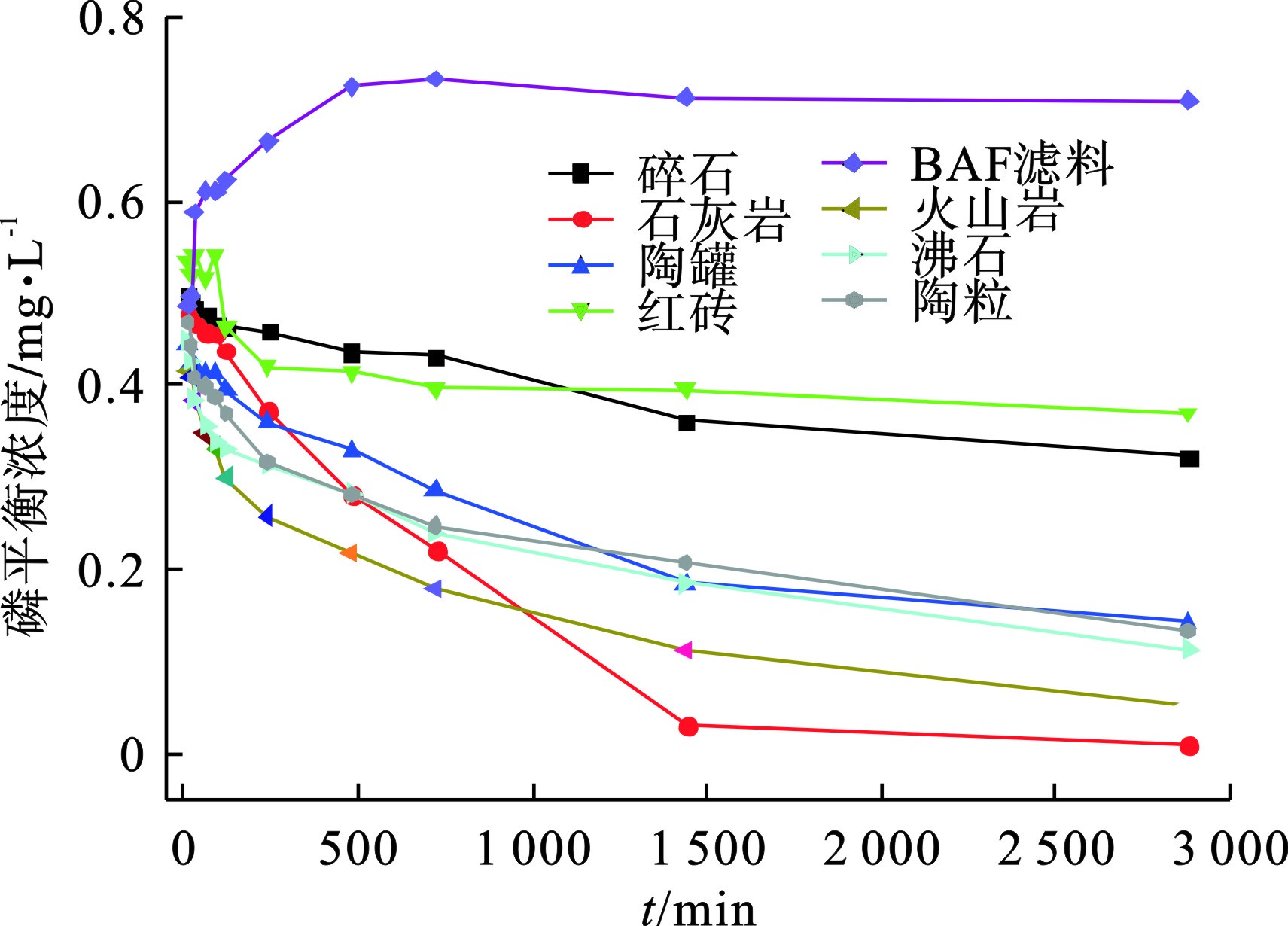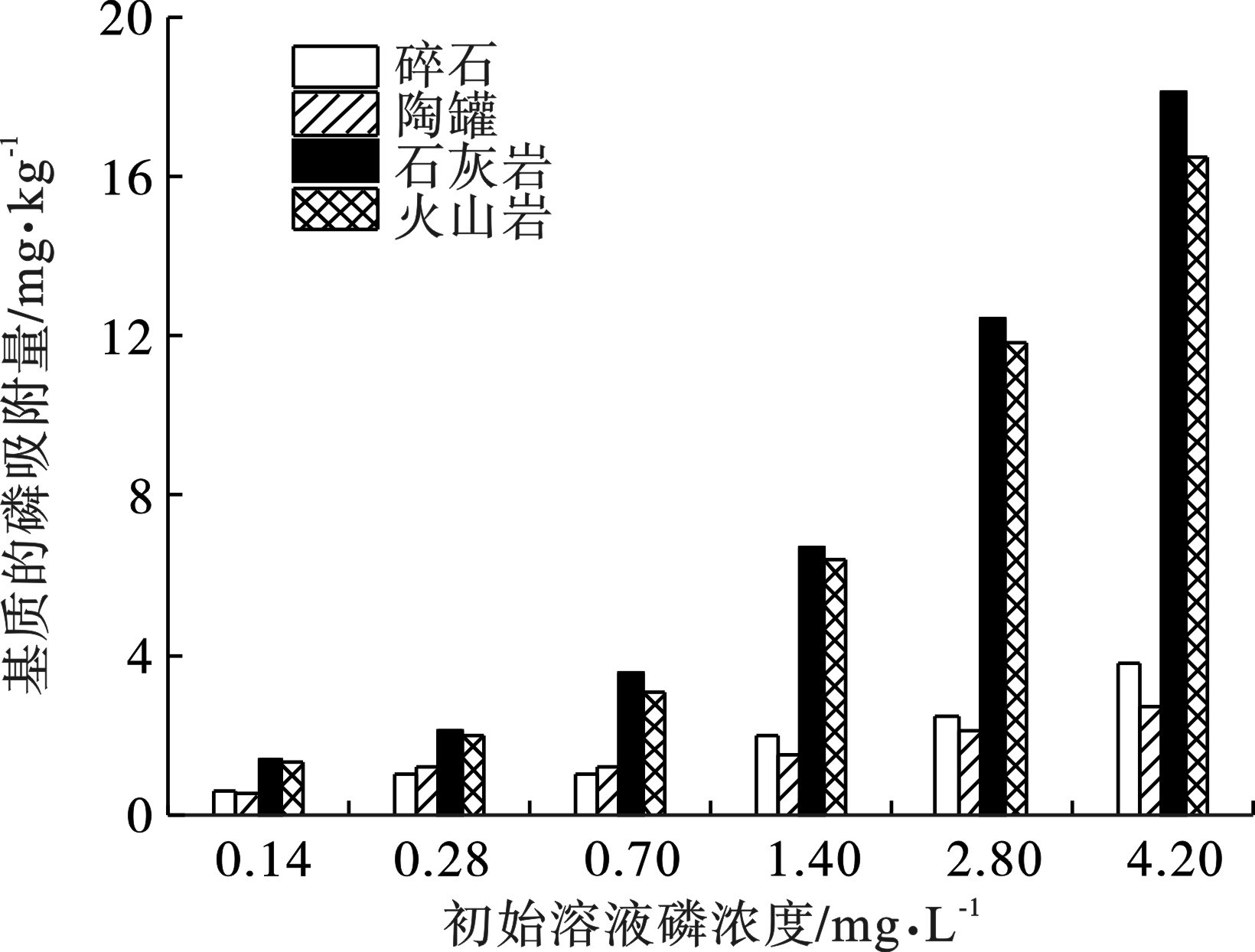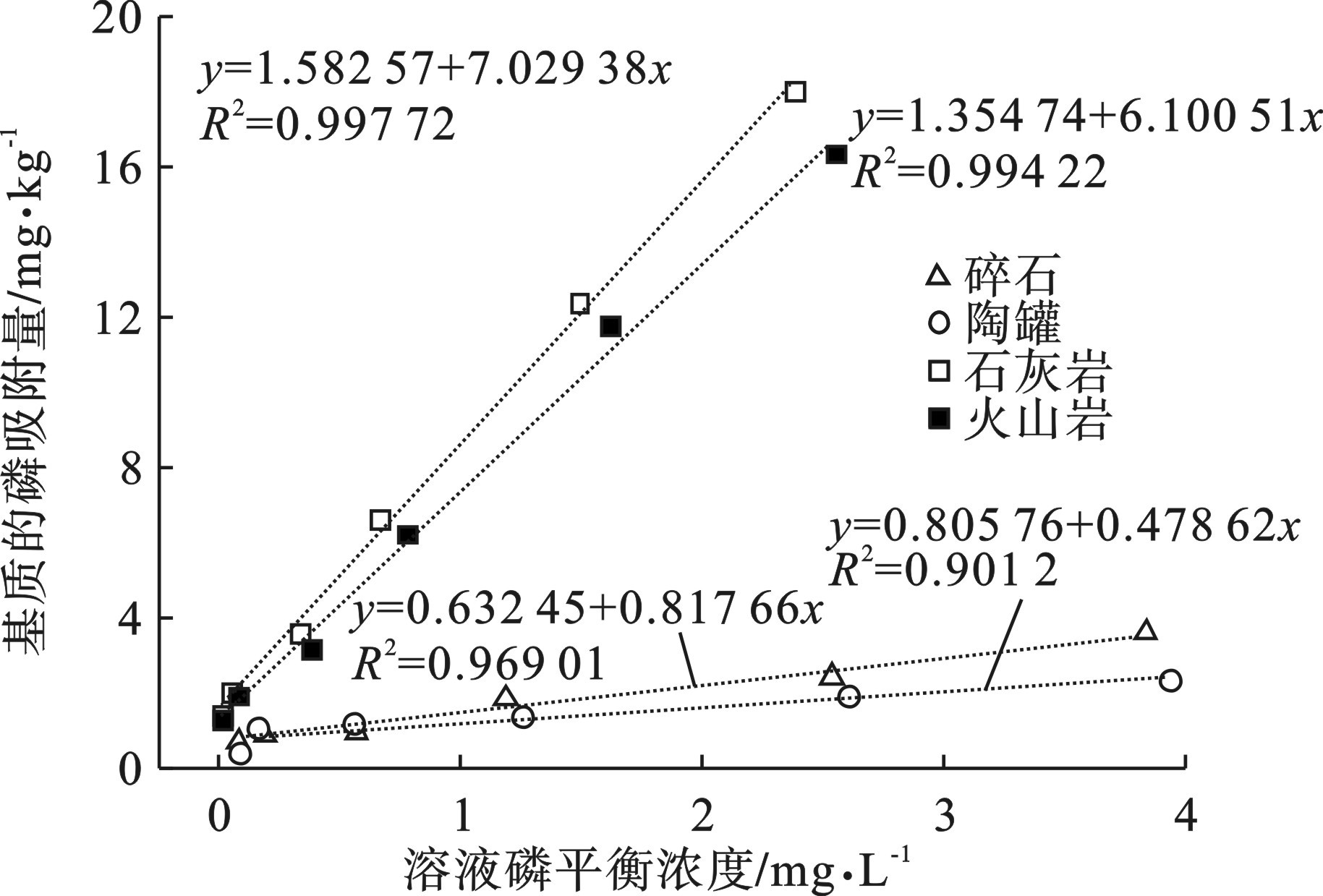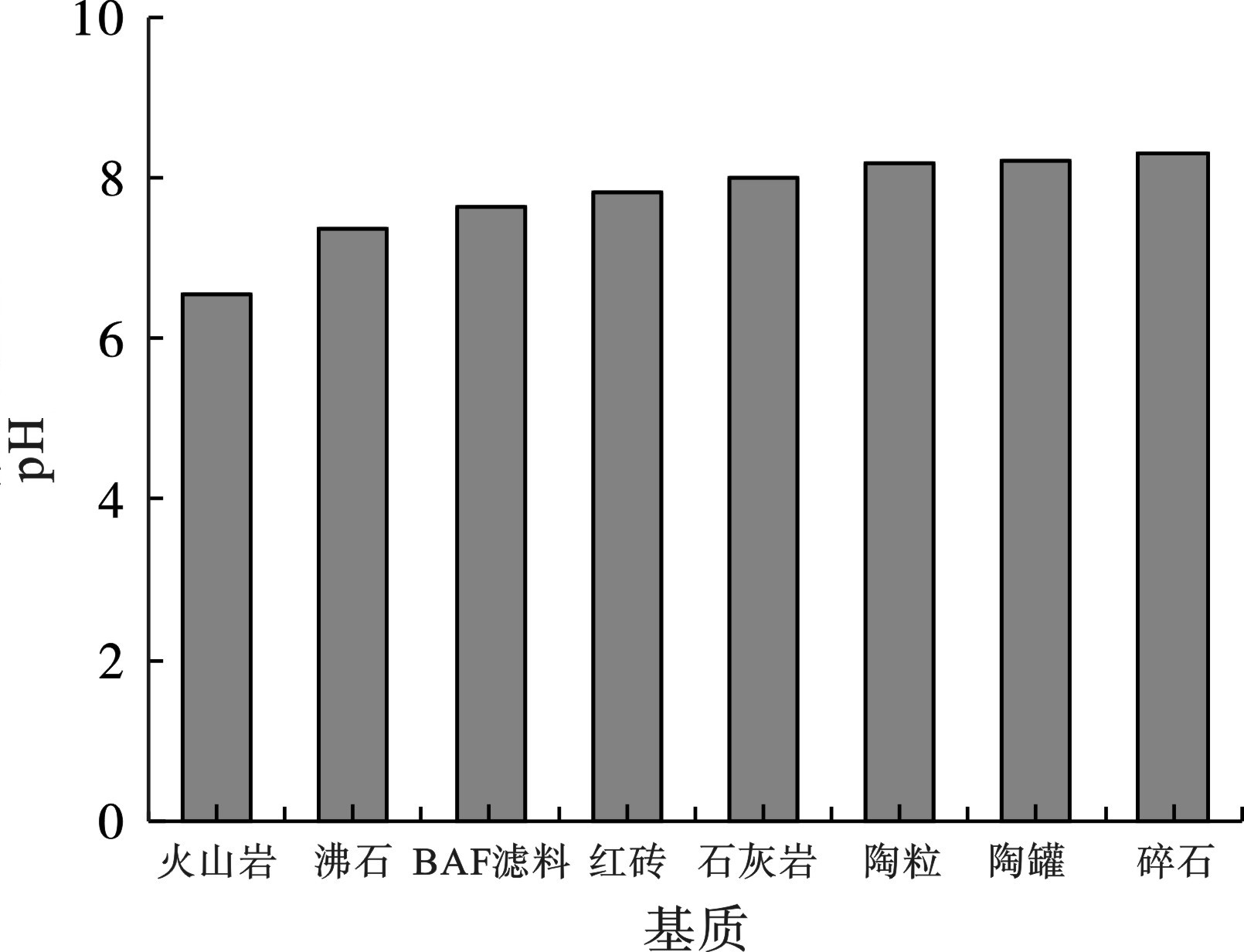-
我国经济快速发展导致水资源需求与水资源总量之间矛盾日益突出,生态环境用水被严重挤占。在此情势下,污水净化后补给生态用水成为普遍选择。我国现行的污水排放标准较为严格,污染物浓度含量较少,但若直接补给进入河流或湖泊等水体,仍将对水环境水生态造成冲击[1-2]。
贵州某酒厂污水处理厂承担着污水收集处理的功能,水质净化达到《发酵酒精和白酒工业水污染物排放标准:GB 27631—2011》的水污染物特别排放限值后,一部分回用于厂区杂用水,一部分排入盐津河并最终汇入赤水河。为了更好地保护赤水河,该酒厂拟对污水处理厂尾水进一步深度处理。
人工湿地技术由于具有运行费用低、管理维护简单等优点,广泛应用于市政污水、工业废水、农业污水、生活污水及暴雨径流的净化[3-5]。近年来,我国更是大量将人工湿地应用于再生水[6]、地表微污染水[7]等低浓度污水的处理。人工湿地主要由植物、基质、水及微生物组成,各部分相互依存、相互关联,共同形成一个半自然半人工的生态系统。基质在人工湿地中占有最大的体积,并在污染物净化去除中起着关键性作用[8]。围绕湿地基质对磷的吸附去除作用已有大量研究,筛选并提出了诸多适用于构建人工湿地的基质类型,主要包括自然基质(碎石、火山岩、沸石等)、人造材料(砖渣、陶粒等)及工业副产物(钢渣、赤泥、无烟煤等)3大类[9-12]。但是,即便同一种基质对不同磷浓度水体的吸附效果也存在较大差别[13-14],这使得基质应用于该酒厂污水处理厂尾水净化时存在不确定性。
本研究共收集5种本地基质并选取另外3种常见基质,对各基质的磷吸附去除性能进行比较研究,筛选适宜于该酒厂尾水深度处理生态湿地构建的本地基质类型。
-
仁怀市及酒厂生产厂区选择5种本地材料作为基质筛选对象:本地的碎石、石灰岩,厂区内的破碎陶罐、厂房废弃红砖,污水处理厂的曝气生物滤池(BAF)废弃滤料。此外,自遵义市某建材公司采购3种常用湿地基质作为实验对比:火山岩、沸石和陶粒。
8种实验材料人工破碎后,采用方孔筛筛分得到粒径0.85~2.00 mm的颗粒作为实验材料。实验材料先用纯净水振荡清洗1 h,再放入烘箱内60 ℃烘干24 h后备用。
-
基质pH在水土比5∶1条件下测定:取过实验材料10 g及50 mL蒸馏水置于250 mL锥形瓶中,于空气振荡器内振荡5 min后静置10 min,取上清液测定。
-
将10 g基质及100 mL含磷溶液置于250 mL锥形瓶中,随后加入3滴氯仿以防止微生物活动。混合溶液采用KH2PO4人工调配,主要污染物浓度为:总磷0.5 mg/L、pH7.8。
将锥形瓶盖严后置于空气振荡器中(室温20 ℃、转速100~110 r/min),取样时间分别为10、20、30、60、90和120 min及4、8、12、24和48 h。到达设定时刻后取出锥形瓶立即过滤,通过0.45 μm滤膜后测定溶解态的总磷浓度。每种基质的实验做3个平行。
-
将10 g基质与100 mL含不同磷酸盐浓度的0.01 mol/L KNO3溶液共同置于250 mL锥形瓶中,随后加入3滴氯仿以防止微生物活动。磷酸盐浓度采用KH2PO4调配,共设置7个梯度,依次为0、0.14、0.28、0.7、1.4、2.8和4.2 mg/L。将锥形瓶盖严后放入空气振荡器中(室温20 ℃、转速100~110 r/min),震荡48 h,通过0.45 μm滤膜后测定溶解态的磷酸盐浓度。每种基质的实验做3个平行。
-
采用X射线光电子能谱(X-ray photoelectron spectroscopy,XPS)分析,型号为ThermoFisher ESCALAB 250Xi。
-
水质分析采用国家标准监测分析方法[15]:总磷采用钼锑抗分光光度法;总氮采用过硫酸钾氧化-紫外分光光度法;氨氮采用钠氏试剂分光光度法。
-
基于实验结果,基质的磷吸附量计算,见式(1):
式中:P为单位基质的磷吸附量,mg/kg;ct为振荡后的溶液磷浓度,mg/L;c0为初始溶液磷浓度,mg/L;V为初始溶液体积,本实验均为0.1 L;M为实验基质的质量,本实验均为10 g。
-
当磷平衡浓度较低时,基质的磷吸附量与磷平衡浓度呈现明显的线性关系,基质的初始含磷量(P0)可按式(2)通过线性拟合得出[16]。
基质的磷平衡浓度(Equilibrium P Concentration,EPC0)可由式(3)计算得出。EPC0指基质与溶液维持“吸附-解吸附平衡”的浓度。
式中:ce为震荡24 h后溶液平衡浓度,mg/L;Pa为达到震荡24 h后基质的磷吸附量,mg/kg;Kd为未考虑基质的初始含磷量P0的情况下,基质线性吸附系数,L/kg。
-
所有实验数据采用EXCEL进行数据统计处理,采用OriginPro 2018制图。
-
根据对磷酸盐的吸附能力对比,见图1,8种基质由大到小分别为:石灰岩>火山岩>沸石>陶罐>陶粒>碎石>红砖>BAF滤料。BAF滤料不仅不具有吸附能力,反而出现磷酸盐释放现象,其原因在于:本研究采用的BAF滤料在污水处理厂中已运行较长时间,不仅已吸附了较多的磷酸盐还附着有部分微生物;而本研究采用的磷酸盐浓度较低,在振荡过程中促使滤料表面的磷酸盐往溶液中释放。红砖及碎石对磷酸盐的吸附能力较低,48 h对磷酸盐的吸附去除率不足20%。其余5种基质则表现出一定的吸附能力,48 h对磷酸盐的吸附去除率均在60%以上。
本研究开展的吸附动力学实验持续时间为48 h,石灰岩、火山岩、沸石、陶罐和陶粒5种吸附效果较好的基质在24 h后的磷酸盐吸附效果均不同程度地减弱。尤其是石灰岩在24 h已将溶液中的磷酸盐溶度从0.5降至0.03 mg/L的极低水平,在24~48 h期间基本未表现出吸附能力。根据这5种基质的吸附特征,以其构建人工湿地的水力停留时间至少应在48 h以上,以充分发挥基质的吸附性能。
-
基于吸附动力学实验结果,选择石灰岩、陶罐、碎石3种具有吸附能力的基质以及对照基质火山岩开展吸附等温实验,以探究基质的磷吸附理论平衡浓度,从而判定其作为湿地基质的潜力。
根据实验结果,见图2,溶液磷酸盐浓度越高、基质的磷吸附量也更大:在磷酸盐浓度0.14 mg/L时,石灰岩的磷吸附量1.40 mg/kg为陶罐的3.03倍,但在当磷酸盐浓度为4.2 mg/L,石灰岩的磷吸附量18.13 mg/kg达到碎石的6.87倍。值得注意的是,当初始磷酸盐浓度大于1.4 mg/L时,碎石的磷吸附量开始大于陶罐,表明碎石更适合于高浓度含磷污水净化。
将磷平衡浓度与基质磷吸附量线性拟合,见图3。随着溶液初始磷浓度的升高,基质的磷吸附量也相应增大,而石灰岩、火山岩的磷吸附量增大趋势明显高于碎石和陶罐。这印证了DRIZO et al[13]结论,即溶液初始磷浓度对基质的磷吸附量有着显著影响。
基于拟合结果,采用式(3)可计算得到各基质的磷平衡浓度。EPC0的意义在于,当溶液浓度为EPC0时,基质在该溶液中既不发生磷吸附,也不出现磷的解吸附。因此,对于净化低磷酸盐浓度水体而言,基质的EPC0较为关键,EPC0偏高则意味着该基质无法将水体中的磷酸盐净化到较低水平。根据表1计算结果,4种基质磷平衡浓度均极低,表明均适宜于净化低磷酸盐浓度的水体。
-
8种基质材料的pH见图4。在8种基质中,火山岩pH最低为6.54,呈现弱酸性;其他基质均呈现弱碱性,pH值在7.38~8.49之间。
由XPS测定的碎石、陶罐、石灰岩和火山岩化学组成,见表2。碎石、石灰岩和火山岩属于天然材料,O元素含量总体较高;陶罐属于人工材料,由于烧结过程中O损失,因而氧含量总体低于天然材料。
基质对磷的吸附效果受到环境温度、pH和水体磷浓度等多因素影响[17],但化学组成被认为是关键因素,尤其是Al、Fe、Ca、Mg等元素,无定形态的金属元素越多、基质的理论磷吸附效果往往越大[18]。石灰岩含有31.95%的Ca元素以及1.06%的Mg元素,pH为8.17,偏碱性的特性有利于其发挥Ca、Mg离子的物理和化学吸附作用。火山岩含有11.56%的Fe元素以及7.04%的Al元素,pH为6.54,偏酸性的特性使Fe、Al离子发挥磷去除能力。而碎石、陶罐的Al、Fe、Ca、Mg元素含量相对更少,磷去除能力也表现得更低。
-
(1)8种湿地基质在净化含磷浓度0.5 mg/L的溶液时,吸附能力由大至小为:石灰岩>火山岩>沸石>陶罐>陶粒>碎石>红砖>BAF滤料。BAF滤料在实验中出现磷的解吸附现象,红砖及碎石对磷酸盐去除率不足20%,其余5种基质对磷酸盐去除率在60%以上。
(2)对石灰岩、陶罐、碎石和火山岩的吸附等温实验结果表明;随着溶液初始磷浓度的升高,石灰岩、火山岩的磷吸附量增大趋势明显高于碎石、陶罐;4种基质的磷平衡浓度均极低,均适宜于净化低浓度含磷废水。
(3)石灰岩较高的磷去除能力在于较高的Ca、Mg元素含量,火山岩在源于其较高的Fe、Al元素含量,而碎石、陶罐的Al、Fe、Ca、Mg元素含量相对较少,磷去除能力也更低。
(4)该酒厂采用本地基质构建生态湿地时,建议以石灰岩为主,适量使用碎石、陶罐。
适用于贵州某酒厂生态湿地除磷的本地基质筛选研究
The local substrates for phosphorus removal in ecological wetlands of a distillery in Guizhou Province
-
摘要: 为筛选适宜于贵州某酒厂生态湿地构建的本地基质,对贵州5种本地基质及3种常用基质开展实验研究。结果表明:各基质净化含磷浓度0.5 mg/L溶液的吸附能力由大至小为:石灰岩>火山岩>沸石>陶罐>陶粒>碎石>红砖>BAF滤料;石灰岩、陶罐、碎石、火山岩4种典型基质的磷平衡浓度均极低,均适宜于净化低浓度含磷废水;石灰岩31.95%的Ca元素及1.06%的Mg元素是其对磷吸附能力较强的原因所在,火山岩则缘于11.56%的Fe元素及7.04%的Al元素含量,而碎石、陶罐的Al、Fe、Ca、Mg元素含量相对较少、磷去除能力较低。综合来看,该酒厂采用本地基质构建生态湿地时,可以石灰岩为主,适量使用碎石、陶罐。Abstract: To select the suitable local substrates for the construction of an eco-wetland in a distillery in Guizhou Province, experimental studies were conducted on 5 local substrates and 3 common substrates. The results showed that the adsorption capacities of the substrates to purify a 0.5 mg/L phosphorus solution, from highest to lowest, were limestone > volcanic rock > zeolite > pottery pot > ceramsite > crushed stone > red brick > BAF filter material. The phosphorus equilibrium concentrations of limestone, pottery pot, crushed stone, and volcanic rock were low, which were suitable for purifying a low-concentration phosphorus-containing wastewater. Limestone had a higher phosphorus adsorption capacity due to 31.95% Ca and 1.06% Mg. Volcanic rocks had 11.56% Fe and 7.04% Al. While gravel and pottery pots had relatively low Al, Fe, Ca, and Mg contents with a low phosphorus removal capacity. When constructing an eco-wetland using a local matrix in the distillery, limestone could be used as the primary substrate, with a moderate use of gravel and pottery pot.
-
表 1 基质磷吸附特性参数
Table 1. Characteristic parameters of substrates phosphorus adsorption
基质 Kd/L·g−1 P0/mg·kg−1 EPC0/mg·L−1 碎石 0.632 45 0.817 66 0.001 29 陶罐 0.478 62 0.805 76 0.001 68 石灰岩 7.029 38 1.582 57 0.000 23 火山岩 6.100 51 1.354 74 0.000 22 表 2 基质化学组成
Table 2. Chemical composition of substrates
基质 化学组成/%a Si Ca O Fe Al Mg 碎石 15.38 7.68 46.89 1.86 4.74 0.75 陶罐 35.67 13.22 20.39 6.62 3.54 0.42 石灰岩 4.39 31.95 37.35 0.76 1.87 1.06 火山岩 21.23 6.96 39.72 11.56 7.04 3.28 注:“a”为该比例为各主要元素的相对质量百分比。 -
[1] 李智, 王怡, 王文怀. 不同水源补给对景观水体水质及浮游动物的影响[J]. 中国给水排水, 2021, 37(5): 91 − 96. doi: 10.19853/j.zgjsps.1000-4602.2021.05.014 [2] 宋莹, 安申群, 陆玉广, 等. 再生水补给差异对浮游动物群落结构的影响——以北京市清河、温榆河、白河为例[J]. 环境保护科学, 2021, 47(4): 83 − 90. [3] KADLEC R H, KNIGHT R L. Treatment wetlands [M]. Chelsea: Lewis Publishers, 1996. [4] VYMAZAL J, KROPFELOVA L. Wastewater treatment in constructed wetlands with horizontal sub-surface flow [M]. Berlin: Springer Netherlands, 2008. [5] 孙家君, 李玉平, 张杨, 等. 梯级人工湿地对水污染的生态修复效果研究概况[J]. 环境保护科学, 2021, 47(4): 24 − 29. doi: 10.16803/j.cnki.issn.1004-6216.2021.04.004 [6] 于文泽, 余昊翔, 张俊慧, 等. “塘+湿地”耦合系统净化再生水补给低C/N河湖水体的效能及机制研究[J]. 环境科学学报, 2021, 41(1): 263 − 272. [7] 蒋宇豪, 李敏, 唐明哲, 等. 砾间接触氧化/水平潜流人工湿地净化微污染河道水[J]. 中国给水排水, 2021, 37(5): 57 − 65. [8] 王文东, 王霞, 郑杰, 等. 模块化人工湿地基质筛选与除污性能评价[J]. 环境污染与防治, 2018, 40(12): 1333 − 1337. doi: 10.15985/j.cnki.1001-3865.2018.12.002 [9] 赵倩, 庄林岚, 盛芹, 等. 潜流人工湿地中基质在污水净化中的作用机制与选择原理[J]. 环境工程, 2021, 39(9): 14 − 22. [10] 万正芬, 张学庆, 卢少勇. 19种人工湿地填料对磷吸附解吸效果研究[J]. 水处理技术, 2015, 41(4): 35 − 40. [11] 王振, 刘超翔, 董健, 等. 人工湿地中除磷填料的筛选及其除磷能力[J]. 中国环境科学, 2013, 33(2): 227 − 233. doi: 10.3969/j.issn.1000-6923.2013.02.006 [12] 莫文锐, 黄建洪, 田森林, 等. 氨氮和磷在三种人工湿地填料上的吸附动力学[J]. 化学研究, 2012, 23(1): 21 − 23. doi: 10.3969/j.issn.1008-1011.2012.01.006 [13] DRIZO A, COMEAU Y, FORGET C, et al. Phosphorus saturation potential: A parameter for estimating the longevity of constructed wetland systems[J]. Environmental Science & Technology, 2002, 36(21): 4642 − 4648. [14] HU C M, SHAN B Q. Phosphorus removal performance and mechanisms of horizontal subsurface flow wetlands constructed with blast furnace slag and gravel in treating reclaimed water[J]. Environmental Engineering Science, 2009, 26(6): 1097 − 1106. doi: 10.1089/ees.2008.0278 [15] 国家环境保护总局. 水和废水监测分析方法(第四版)[M]. 北京: 中国环境科学出版社, 2002. [16] REDDY K R, CONNER G A O, GALE P M. Phosphorus sorption capacities of wetland soils and stream sediments impacted by dairy effluent[J]. Journal of Environmental Quality, 1998, 27(2): 438 − 447. [17] RICHARDSON C J. Mechanisms controlling phosphorusretention capacity in freshwater wetlands[J]. Science, 1985, 228: 1424 − 1426. doi: 10.1126/science.228.4706.1424 [18] OGUZ E, GURSES A, YALCIN M. Removal of phosphate from waste waters by adsorption[J]. Water Air and Soil Pollution, 2003, 148(1-4): 279 − 287. -





 下载:
下载:




